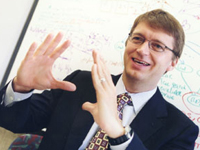
Computerized Matching System Could Enable National Kidney Exchange
Contact: Byron Spice, 412-268-9068, bspice@cs.cmu.edu; Anne Watzman, 412-268-3830, aw16@andrew.cmu.edu; both with Carnegie Mellon University Media Relations
Photo: Tuomas Sandholm
This step-by-step method, or algorithm, could significantly boost the efficiency of kidney exchanges, a mechanism for matching live donors with unrelated recipients. Kidney exchanges are now considered the best chance for boosting the number of kidney transplants in the
The matching algorithm makes it possible to create matches for three- and four-way exchanges - that is, three or four donors matched to three or four recipients - as well as two-way exchanges. It is the first that is scalable so it can be used for a national pool of donors and recipients, said Tuomas Sandholm, professor of computer science.
A paper detailing the algorithm, developed by Sandholm, Computer Science Professor Avrim Blum and graduate assistant David J. Abraham, will be presented Friday, June 15, at the Association for Computing Machinery's Conference on Electronic Commerce in
The
For instance, in a match run in early May, the algorithm identified four potential two-way exchanges, three three-way exchanges and one four-way exchange among about 100 donor-patient pairs and seven altruistic donors. Whether any of those transplants take place will depend on factors such as final compatibility testing, Rees said. With the same set of donor-patient pairs and without altruistic donors, the matching method previously used by the
About 140 paired kidney donations have occurred in the
Sandholm said the number of transplants could be increased by expanded use of three-way exchanges - donor A gives to recipient B, donor B gives to recipient C and donor C gives to recipient A - and four-way exchanges. Numbers could also be increased by enlarging the pool of donor-patient pairs, he added.
Several regional exchanges are in operation and the possibility of a national exchange has been discussed. Rees predicted that in perhaps five years a national pool could include 3,000 donor-patient pairs and accumulate 1,000 to 1,500 pairs each year. Potentially, as many as 2,000 transplants could be performed from a pool of this size if three- and four-way exchanges are arranged, he said. But existing matching algorithms can arrange only two-way exchanges for such a large pool, and current algorithms capable of arranging three- and four-way exchanges can handle no more than 600 to 900 pairs.
"Computer memory is a limiting factor in optimizing kidney exchanges," Sandholm said, noting the large number of constraints, such as differing blood and tissue types, that must be considered. "We work around this by using incremental problem formulation," he said. That is, the algorithm devised at Carnegie Mellon doesn't consider all of the constraints at once, but formulates them in the computer's memory only as needed, enabling it to analyze up to 10,000 donor-patient pairs.
Carnegie Mellon is a private research university with a distinctive mix of programs in engineering, computer science, robotics, business, public policy, fine arts and the humanities. More than 10,000 undergraduate and graduate students receive an education characterized by its focus on creating and implementing solutions for real problems, interdisciplinary collaboration, and innovation. A small student-to-faculty ratio provides an opportunity for close interaction between students and professors. While technology is pervasive on its 144-acre campus, Carnegie Mellon is also distinctive among leading research universities for the world-renowned programs in its




 Sign Up to Receive Press Releases:
Sign Up to Receive Press Releases: